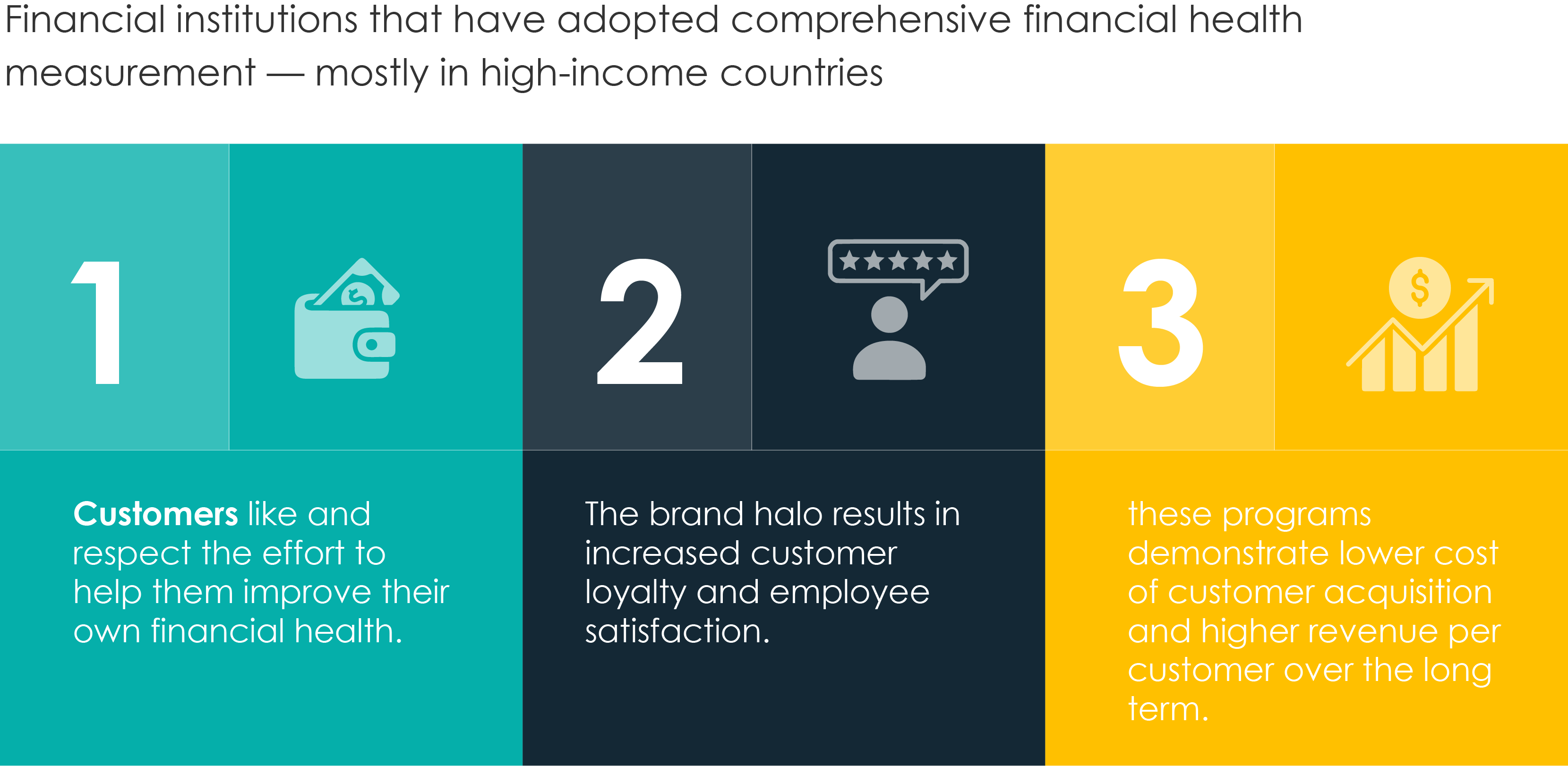Financial health in Mexico: A new tool for measurement

Purpose
Recovery from the economic effects of the pandemic will require millions of microentrepreneurs to rebuild their balance sheets. Every microentrepreneur has many different financial needs: protecting against yet another shock, saving for the future, and borrowing to get the business back on track. What should she focus on first? A trustworthy financial institution will be her partner in addressing those various needs with different products and, sometimes, individualized advice or educational programs.
A financial health score for each customer could provide the financial service provider with timely and actionable information about the customer’s financial needs. Financial health offers a simple way to measure the financial outcomes that matter most; which we think of as the reasons that financial access and behavior are important. National efforts to standardize the measurement of financial health (sometimes called financial wellbeing) build on a strong foundation of metrics for financial inclusion. Today, we share an index of financial health that can be measured rapidly and cheaply at scale, developed in a months-long collaboration with two financial cooperatives in Mexico, generously underwritten by MetLife Foundation.
In the coming months, we will develop a digital platform for financial institutions with various digital channels to deploy this question set for their members and customers, so they can measure financial health efficiently in the Mexican context. From WhatsApp chatbots to web-based surveys, these can be integrated across multiple touch-points of their digital marketing strategies and many other digital and in-person interactions with customers.
How it works
Every member of a cooperative or client of a financial institution can obtain a score for his or her own financial health by answering twelve simple questions. These questions are simple enough to be answered without assistance from an interviewer, or they could be part of a face-to-face conversation with a representative of the financial institution. Answering the questions takes about three minutes in practice, and requires no financial disclosures. As soon as the interview is complete, the responses are converted to a simple number from zero to 10.
Imagine one of those millions of microentrepreneurs, let’s call her Isabel, applying for a loan to get back to business after a very difficult year. Despite highly volatile income in the past year, she has skillfully managed her cash and met all of her obligations. She needs to rebuild her emergency fund and make a new plan to save up for her long-term goals. Perhaps she is hoping to buy a little bit of land to secure her future. Although she has never missed a payment with her cooperative, she has begun to feel worried about money for the first time in a long time. The financial health index must reflect each of four aspects of her financial health: day-to-day, opportunities, resilience, and agency (Table 1).
| Aspect of financial health | Definition |
|---|---|
| Day-to-day | Demonstrating success in aligning current income and expenditures |
| Opportunities | Having specific plans and services to achieve financial goals for the future |
| Resilience | Having specific assets and services in place to prepare for shocks |
| Agency | Experiencing (subjectively) confidence and control in financial affairs |
The set of questions below covers the four components of financial health. None of these topics is treated in detail, because the index can only provide a broad-brush overview of the member’s or client’s financial situation. The questions are intended to be easily read and understood; and they follow widely accepted measurement principles (1). Although the questions were administered in Spanish for our calibration study, they are presented here in English (Table 2).
| “I will read a series of statements to you. For each one, please tell me whether you agree or disagree with it, on a scale from 1 to 5, where 1 is total disagreement, 3 is neither disagreement nor agreement, and 5 is total agreement.” |
|---|
| When I think about the money I need during a typical day, I usually have enough to cover essentials. |
| I can usually make my money last until the next time I receive income. |
| I have a budget or a plan that I use to guide monthly spending. |
| Currently, I am on track to accomplish my financial goals. |
| Currently, I have set aside money to meet large, irregular expenses, such as an emergency. |
| My debt is manageable - I am able to pay off what I owe when it is due. |
| I owe more than what all my assets are worth. |
| If I lost all my income and had to survive on what I have put aside, I would be able to pay for essentials for four weeks, without borrowing money or selling something. |
| In the last year, there has been at least one time when I went without medicine or medical treatment because I did not have the money for it. |
| I have insurance that is enough to protect my home, my belongings, and my family. |
| I have a large degree of control over my current financial situation and expect to have the same in the future. |
| In the last one year, my financial situation has caused me stress. |
These questions include three related to budgeting, meaning how the person aligns his or her expenses with available funds for the month. Three questions are related to attaining financial goals; four are related to resilience; and two are related to agency, or a subjective sense of control and wellbeing about financial affairs.
Methods
FinnSalud fielded a survey of the members of two financial cooperatives in Mexico that was completed in February, 2021. Respondents were selected at random from the cooperatives’ member lists. The total number of completed interviews was 1,524. The response rate to the survey was 39%. The duration of the financial health module of the interview (the twelve-question set) was three minutes long. Interviews were conducted by computer-assisted telephone interview (CATI).
To calculate the financial health score, we first convert the response to each question to a number from 1 to 5, ranging from the weakest to the strongest possible response to the question. Then the scores are fed through a function that creates a weighted average of the responses and rescales the results so that the average falls between zero and 10.
FinnSalud calibrated the scorecard for financial health with data from the February survey, using a structural equation model. The results of the model were validated against a lengthy interview about respondents’ saving, borrowing, budgeting, resilience, and confidence in financial affairs.
The structural equation model allows for the possibility that different aspects of financial health vary independently. Each individual’s day-to-day budgeting might be only loosely related to their resilience. Thus our model first divides the twelve questions into groups that surfaced from an exploratory data analysis, and then uses a structural equation model to assign point values to each question on the scorecard. The resulting scorecard is slightly more complicated than those developed for financial health indexes in Australia (2) and the United States (3), but the tradeoff of fidelity for complexity is worth it.
Discussion
We are convinced by months of research that a simple, cheap, and reliable tool to measure financial health could catalyze positive and mutually beneficial changes in the relationships between financial service providers and customers like Isabel.
Measurement is a necessary step in the process to advance financial health. Credible data on financial health allow management to make informed decisions about product design, programs and strategy. It allows objective comparisons of different customer segments. It provides a basis on which to track outcomes that matter to customers, in addition to traditional measures of risk and profitability.
Indeed, the benefits of financial health revolve around deepening the relationship with the customer. Measuring financial health reorients the conversation away from creditworthiness — a polite way of referring to default risk — and toward the customer’s wellbeing. The cooperative can focus on selecting products or offering services that are most likely to promote effective budgeting, manage uncertainty, grow savings, and use debt wisely.
There are inherent risks whenever a lender asks a borrower to disclose material information about their financial health. This index is only a measurement tool. We cannot eliminate the risk that lenders could leverage the index to inform credit decisions or for other business purposes. So we don’t want to suggest that there are no risks associated with collecting this data. Yet, in practice, cooperatives already have multiple measures of credit risk and procedures to govern lending decisions. Cooperatives do not have a strong incentive to use data collected in this manner for other purposes.
Cooperatives must treat their members with dignity if they are to be successful in measuring financial health at scale. Individuals will provide honest information when there is a foundation of trust with their financial institutions. That entails simple and transparent commitments from the cooperatives about the confidentiality and uses of data collected, consistent with evolving standards for data privacy.
Financial institutions that have adopted comprehensive financial health measurement — mostly in high-income countries — report three important changes as a result of the effort. First, customers like and respect the effort to help them improve their own financial health. Second, the resulting brand halo results in increased customer loyalty and employee satisfaction. Third, the financial results of these programs demonstrate lower cost of customer acquisition and higher revenue per customer over the long term.
The way forward
We envision this score as a product under rapid iteration. This financial health index requires no financial disclosures, no information about account balances or payment history, and no calculations about assets or credit available. The questions are phrased in simple and intuitive language that is designed to be understood by cooperative members.
We see numerous applications of financial health to strategy, product design, consumer protection, and advocacy. A financial health score could put concrete metrics behind the principle, “do no harm.” Financial institutions could track changes in financial health among users of specific products over time. Customer engagement and marketing could be targeted toward individuals with specific financial health status.
Financial service providers could use financial health metrics to open the conversation with customers about wellbeing, and even incorporate that conversation into the user experience for digital financial services.
References
- Rhyne E. Measuring financial health: What policymakers need to know [Internet]. Cenfri; 2020. Available from: https://cenfri.org/wp-content/uploads/Measuring-Financial-Health.pdf
- Comerton-Forde C, Ip E, Ribar DC, Ross J, Salamanca N, Tsiaplias S. Using survey and banking data to measure financial wellbeing. Commonwealth Bank of Australia and Melbourne Institute Financial Well-being Scales Technical Report. 2018 Mar(1).
- Consumer Financial Protection Bureau. CFPB Financial Well-Being Scale: Scale Development Technical Report. 2017 May.



